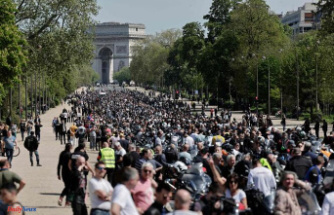The police in Beijing tried late into the night to disperse demonstrators in the diplomatic district. People are gathering again on one of the main traffic arteries for a new protest. Anger at the government is now breaking out in many major cities.
Scores of people have been arrested in the largest wave of protests in China in decades. The weekend's demonstrations continued throughout the night in many cities and continued into the early morning. The people's displeasure is directed against the strict measures of the Chinese zero-Covid policy such as repeated lockdowns, mass tests and forced quarantine. In the early hours of the night, a large contingent of police in the capital Beijing took action against hundreds of protesters near the diplomatic district. Meanwhile, at least a thousand people gathered again in the morning on one of the city's main thoroughfares and chanted: "We don't want masks, we want freedom.
As a symbol of resistance and protest against censorship, many demonstrators held up blank white sheets. Slogans like "lift the lockdown" and "we don't want PCR tests, we want freedom" were shouted. There were also protest marches in other megacities such as Shanghai, Chengdu, Chongqing, Wuhan, Nanjing and Guangzhou. Dissatisfaction is also stirring at universities such as Tsinghua University in Beijing. It was unclear how many people were arrested. China was in virtual news blackout. In Shanghai, the BBC reporter Ed Lawrence was arrested on the fringes of a protest and said he was mistreated by the police.
These are the largest protests in China since the democracy movement in 1989, which the military brutally crushed on June 4 of that year. Social media were full of video recordings, which were quickly deleted by the censors. People are less and less willing to bow to the measures, and unrest breaks out. In Urumqi, capital of western China's Xinjiang region, there were protests on Friday. One of the longest lockdowns was imposed there: Many of the four million inhabitants are not allowed to leave their homes for up to 100 days.
A fire in a skyscraper in Urumqi killed ten people on Thursday. The view spread on social networks that the building was partially locked and therefore many residents did not make it out in time. At a press conference, the authorities denied that anti-corona measures had hindered escape and rescue efforts. Vigils were also held in other cities, including the universities of Nanjing and Beijing.
Due to the extremely rigid measures taken by the authorities in the fight against the corona virus, dissatisfaction among the population has been increasing for weeks. Many megacities are largely paralyzed. People are bothered by the constant tests, curfews, forced quarantines, close surveillance by corona apps and contact tracing with which the authorities are trying to get a grip on the easy-spreading omicron variants of the virus. Even in the case of individual infections or suspected cases, entire blocks of flats and residential complexes are cordoned off.
Angry residents tore down cordons in Beijing and elsewhere. Shops, restaurants and schools are closed in the capital. Experts estimate that a fifth of the second largest economy and thus hundreds of millions of people across the country are likely to be affected by lockdowns. Many companies are reaching their limits. Employed workers and migrant workers in particular often have to accept painful wage cuts.
Despite the rigorous action against the virus, the billions of people are currently being hit by the worst corona wave since the pandemic began almost three years ago. The Health Commission reported a record high in the country on Monday with around 40,000 new infections. In Beijing there were almost 3,900 cases.












